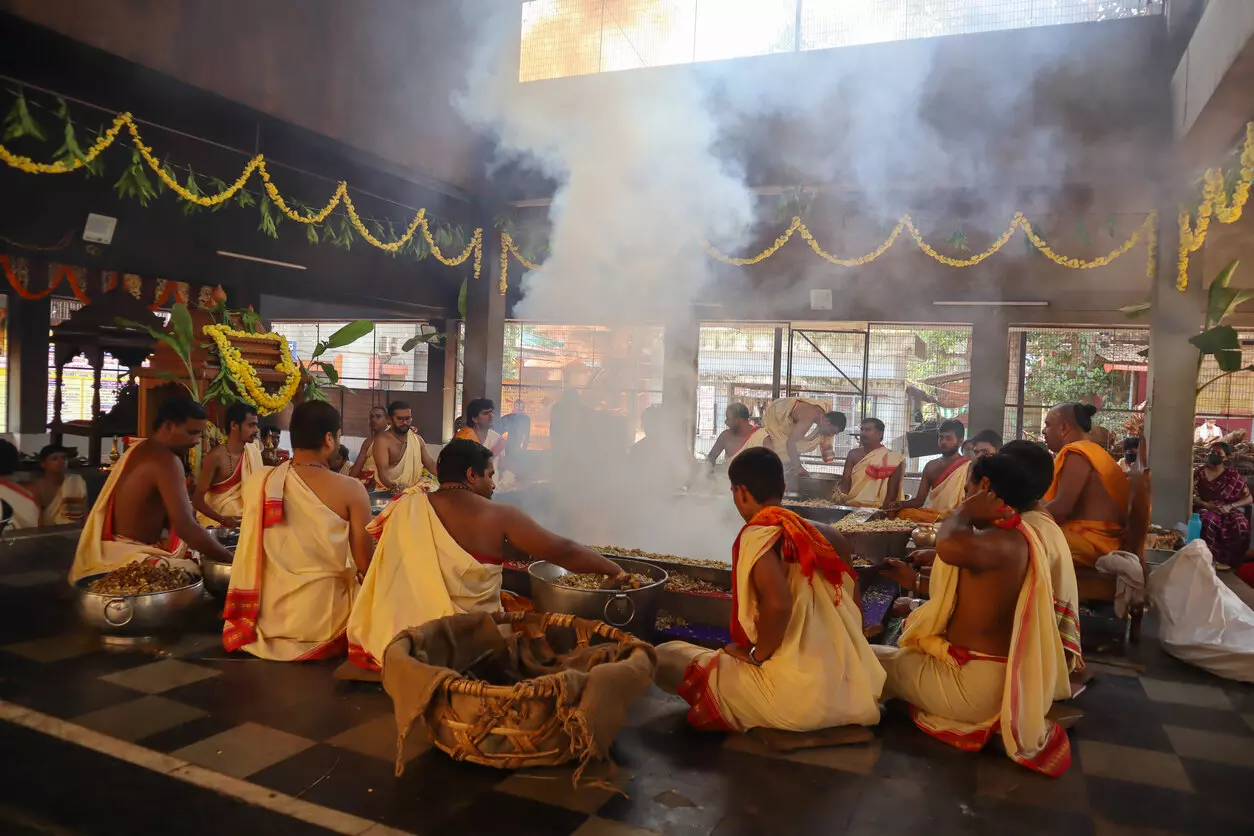
Kerala temples are embracing inclusivity; Koodalmanikyam shows the way
Despite boycott by Brahmin tantric families against appointment of assistants from a different lineage, temple rituals went unaffected, forcing the latter to withdraw protest

The lukewarm response that the boycott by Brahmin ‘tantri’ families against the appointment of a new ‘kazhakam’ (garland and ritual assistant) at Thrissur’s Koodalmanikyam temple received shows how temples, guided by Kerala’s long history of social reforms, despite being under hereditary control, are slowly embracing inclusivity.
Kazhakam appointment, row over lineage
The controversy began earlier this year when Balu KA, hailing from an OBC caste, was selected for the ‘kazhakam’ post. Soon after his appointment, objections were raised against it by some of the temple’s tantri (priest) families, who argued that only those from certain lineages traditionally associated with temple service could hold the role. Facing strong opposition, despite getting a favourable court order and government backing, Balu resigned, stating he did not wish to be the cause of discord in the temple.
Also read: CPI(M) shifts stance on Sabarimala women's entry issue as Ayyappa Sangamam nears
Following Balu’s resignation, KS Anurag, another worker, was appointed as the new kazhakam. The tantris renewed their objections, claiming the appointment violated the temple’s hereditary ‘karayma’ system, which reserves certain responsibilities for specific families. When the Devaswom Board upheld Anurag’s appointment, the tantri families declared they would boycott rituals, including the high-profile ‘Prathishta Dinam’ (consecration day), stating that participation after a “ritual violation” would render the ceremonies meaningless.
Tepid response
However, despite the boycott by tantris, temple rituals continued uninterrupted. Devotees attended as usual, and temple operations proceeded without disruption. Within days, the protest began to falter. One by one, the tantri families withdrew, and the temple’s schedule returned to normal.
Insiders noted that the failure of the boycott demonstrated the limits of hereditary privilege in the modern administrative structure of Kerala temples. The Devaswom Board maintained its appointments, temple rituals continued, and devotees largely ignored the protest.
A small administrative measure further symbolised the shift. A water line was installed from the ‘thidappally’ (the temple kitchen) to the area where garlands are prepared, allowing workers to access water without depending on others. While seemingly minor, this change reinforced the idea that the temple can function independently, irrespective of boycotts by hereditary employees.
Also read: Will the Ganges turn impure if non-Hindus take a dip?
Reforms broke caste barriers
Historically, kazhakam positions at Koodalmanikyam were taken up by ‘Warrier’ families on a rotation basis. Two families relinquished these rights in the 1980s, and since 1984, the Devaswom Board has administered appointments, including from ‘Ambalavasi’ communities (meaning temple premise dwellers – the upper caste who are traditionally entitled to do the temple chores). The recent protest, however, reiterated the persistence of caste practice perceived as hereditary rights and traditional hierarchies.
While temple entry itself has been largely democratised over the past century, posts such as kazhakam remain flashpoints when traditional families feel their authority challenged.
“Even in 1946, the Koodalmanikyam temple authorities did not allow ‘Avarnas’ (Dalits) to pass along the road in front of the temple, nor did they permit them entry through the traditional pathways. It was only through the large-scale protests led by the Communist Party, the Pulayan Mahasabha, and the SNDP Yogam that the right to passage was won,” said historian Dr mal C Rajan.
Also read: Bengaluru widow accuses two Kerala temple priests of blackmail; one nabbed
“During the tenure of C Achuthamenon as the chief minister, ordinances were introduced to democratise the feudal system of the Koodalmanikyam, and in 1971, the Koodalmanikyam Temple Act was passed. The appointment of a young Ezhava as kazhakam continues this legacy of democracy and social reform. Now it has become evident that the temple’s activities are sustained by collective effort rather than by the exclusive authority of the tantris. The smooth continuation of poojas during the boycott shows that ritual authority alone can no longer dictate outcomes in a temple that functions under statutory oversight”, added Dr Rajan.
Hereditary privilege still a reality
The dispute highlights broader issues in Kerala’s temples, where caste and lineage continue to influence access to roles behind the veil of ritual life. While temple entry itself has been largely democratised over the past century, posts such as kazhakam remain flashpoints when traditional families feel their authority challenged.
Also read: The unique Gods of religion-neutral Kerala temples
Insiders noted that the failure of the boycott demonstrated the limits of hereditary privilege in the modern administrative structure of Kerala temples. The Devaswom Board maintained its appointments, temple rituals continued, and devotees largely ignored the protest. However, the inherent casteism does operate subtly and in a disguised manner.
While in Koodalmanikyam the tantri families framed their protest as a defense of tradition rather than caste, the event has reignited public discussion about how caste dynamics continue to shape temple life in subtle ways.
Lesson in inclusivity
The Koodalmanikyam incident illustrates that change is gradual, often quiet, and occurs not through confrontation but through the normalisation of procedures that prioritise inclusivity and statutory governance.
One temple staff member summed up the outcome succinctly: “The rituals went on, the devotees came, and the temple doors opened and closed every day, just like before. That was the real answer.”
Also read: Kerala temples switch to lifelike robotic elephants from real ones
For Kerala, a state long associated with social reform and temple entry movements, the Koodalmanikyam row is a reminder that while physical access may be open, the negotiation of roles, responsibilities, and ritual authority remains an ongoing process. The failure of the boycott reflects a subtle but significant shift: temple traditions are adapting to modern administrative frameworks, and hereditary control, while respected, is no longer absolute.

